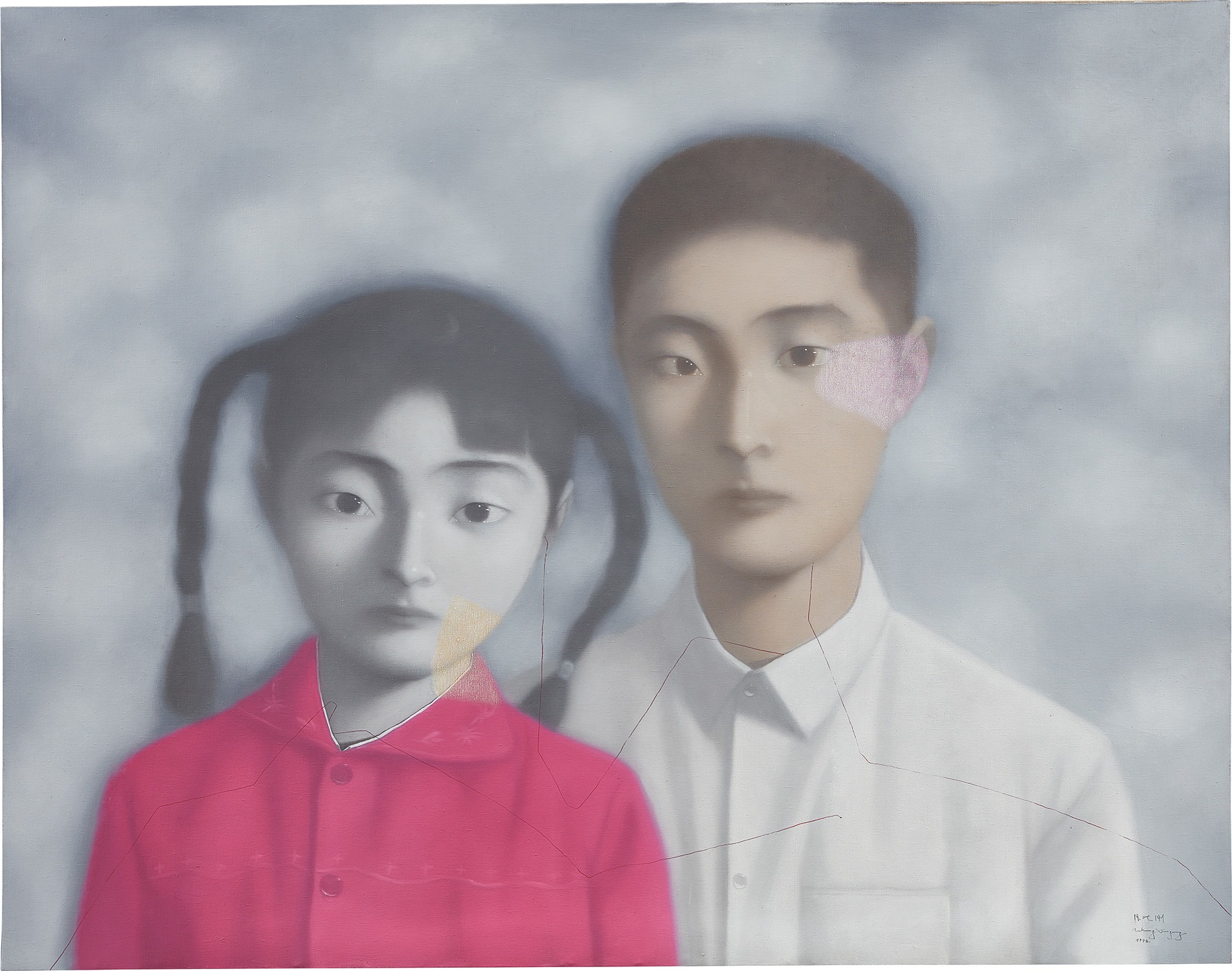

18Ο✱
Zhang Xiaogang
Bloodline: Big Family No. 11
Full-Cataloguing
A critical symbol central to the Bloodline series, sliver thin red threads weave around a young boy and girl in Bloodline: Big Family No. 11, as they stare straight ahead at the viewer. Wearing solemn, distant expressions, modest attire and conservative haircuts, the two subjects each bear the typical appearance of a member of collectivist-era China. Zhang’s children are precocious; depicted as too mature for their ages, shaped by the restrictions and rules set by adult society. The artist borrows the language of photography in his works, staging its composition to resemble that of old family photographs from that era. As a later work from his series, the present work is the product of years of practice replicating the soft ambient glow and lens glare of old black and white photographs. This allowed the artist to introduce more light into his paintings compared to earlier works, and to achieve a luminous effect through the use of multiple layers of thin paint. The photograph functioned as a mode of documenting individual memories in time, as well as preserving a moment in real life for posterity. However, inspired by Gerhard Richter’s works, Zhang started exploring the psychological and emotional potential of photography: how a simple, direct family portrait taken in a studio can carry the emotional burden of history, illustrate the complexities of the individual versus the collective identity, as well as fulfil people’s nostalgia for old film. To paint works that look realistically like photographs, Zhang essentially creates ‘fake’ images composed of many different pictorial references and memories.
Against a predominantly monotone palette, the viewer’s eye is automatically drawn to the girl’s attire, highlighted in a striking hue of pinkish red. Though one would assume that the choice of colour is related to the red flag of the Cultural Revolution, in an interview with the artist he explained that the colour choice was simply a new red that he had seen and purchased in fabric stores at the time:
“Works created between 1995 to 1996 carried a strong sense of national identity, you could tell at first glance from the communist attire that they were living through the Cultural Revolution. From 1998 onwards, I wanted to gradually soften this image and to make my works more dreamlike. At this point, I started pursuing a lighter palette, with more illusory qualities in the works as compared to the darker, more sombre palette I used before.” (Zhang Xiaogang, quoted in Zhang Wenjia, “Interview with Zhang Xiaogang”, March 2019)
The emphasis on attire highlighted the artist’s decision to steer away from the strong political connotations that his earlier works carried, with their communist uniforms and darker tones (see for example the artist’s Portrait, 1996). The change in attire extended the work’s relevance for people living in China between the 1960s and 1990s, not just for those who experienced the Cultural Revolution, but also into the modern and contemporary era.
It is also important to consider that the present work was created after the birth of the artist’s daughter in 1994. At the point of execution, Zhang Xiaogang’s daughter would have been about 4 years old, and the children in the painting are conceivably modelled upon a similar age range to that of hers. However, instead of documenting the contemporaneous experiences of his daughter in the 1990s, the old black-and-white photographic style of the work conveys the experiences from the artist’s own childhood. An image that presents a narrative of time and family, the thin red bloodlines connect the young boy and girl as siblings – not related by birth, but as a part of a nation that emphasised unity and conformity in Mao’s communist era. The painting thus represents the collective memories of entire generation of children who lived and grew up during the Cultural Revolution, imbuing the work with a poetic sense of nostalgia and of changing times.
Zhang Xiaogang’s iconic Bloodline series not only explores collective and self-identity through the nation’s historical memories, mature works such as Bloodline: Big Family, No. 11 provide insights into his own personal life, offering a piece of complex emotional and psychological history that is universally relatable.
Phillips would like to thank Zhang Xiaogang for his assistance with this essay.
Zhang Xiaogang
Chinese | 1958Relying on memory and inspired by family portraits from the Chinese Cultural Revolution, Zhang Xiaogang creates surreal, subtle artworks that explore the notion of identity in relation to the Chinese culture of collectivism. Using a muted, greyscale palette, Xiaogang repeatedly depicts a series of unnervingly similar figures, often dressed in identical Mao suits, to create an endless genealogy of imagined forebears and progenitors. Their somber, melancholy gazes are interrupted only by thin red bloodlines intimating familial links as well as occasional pale splotches of color resembling birthmarks.
Xiaogang investigates how to express individual histories within the strict confines of a formula. His sitters, while appearing muted and compliant, are given physical exaggerations: oversized heads, tiny hands and long noses. These distortions imply stifled emotions and give a complex psychological dimension to the artist's work.